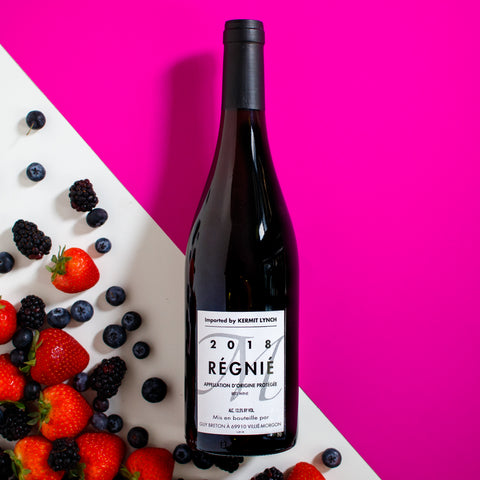Cru Beaujolais: Focus on Régnié
This is part seven in a series on the Crus of Beaujolais. To get more context on this fabulous wine region check out the blog that introduces the crus.
For now, let's turn our attention to Régnié.
Well, we've done all the big and famous Crus, but the little ones are still worth talking about. And drinking! We’ll start today with Régnié, before moving on to Saint Amour and Chénas.

Régnié is yet another Cru named for an old Roman guy, in this case someone named Reginus who had a villa in the area where he made wine. Even with that history, Régnié only became a Cru in 1988, after years of lobbying by local growers.
Régnié lies between Morgon and Brouilly, but extends further west than its neighbors, into an area where Beaujolais-Villages grows. In fact, Régnié covers a couple of acres that are in the village of Lantignié, one of the more celebrated villages of Beaujolais-Villages. This history may give inspiration to those growers in Lantignié who hope to see their village elevated to Cru one day, too.
You can see why the local growers succeeded in elevating Régnié to Cru status by looking at its terroir: Régnié has more of the Cru-defining granite than just about any other village. It is hilly, though not particularly steep, and a little higher in average altitude than Brouilly or Morgon. Régnié has what it takes to make great Beaujolais.
And it does! Régnié’s wines borrow from its neighbors, showing the brighter red fruits associated with Brouilly, with some Morgon-like body and structure. But it also has its own special features that distinguishes it from its neighbors: I taste a spicy note, and the red fruit here is more raspberry than cherry or currant.

Régnié’s Church, nestled among the vines.
Some of Beaujolais’ best producers make wine in Régnié, and often they are the most delicious wines in those producers' line-ups for drinking young! If I am faced with a choice of a number of one- or two-year-old Cru Beaujolais, I will often reach for a Régnié. It is only at about age 5 that other Crus generally start to look more interesting. As the vast majority of Cru Beaujolais is consumed much younger than that, this is a great advantage of Régnié.
Look for the Régnié from Guy Breton, who is one of the “Gang of Four” Morgon producers who popularized the Chauvet method. Half his Régnié vines are over 100 years old! Breton’s is a great example of Régnié that balances the pretty aromatics and raspberry fruit with Morgon-like grip.
But perhaps the deepest and most profound Régnié is made by Georges Descombes, who produces a Vieilles Vignes (old vine) version that can be extraordinary. He, too, is a Morgon producer who follows the Chauvet method.
His step-son Damien Coquelet also makes a wonderful and all-natural Régnié. Finally, for a more Burgundian take on Régnié, there is Jules Sunier, whose plot is actually at the base of the Côte de Py in Morgon. It’s got nice old vines and the wine is fuller bodied than typical Régnié.

While there are not many well-known artisans specializing in Régnié, Julien’s younger brother, Antoine Sunier is an up-and-comer you should get to know. Antoine trained with his brother for years before stepping out on his own in 2014, and today makes two limited but delicious Régniés that really exemplify the Cru (as well as one wine from neighboring Morgon). He works with minimal interventions, using so little sulfur that it’s usually undetectable in the finished wine. He ferments in a classic, semi-carbonic style, which preserves the Régnié raspberry fruit, as well as the spice notes. His single-vineyard, “Montmerond,” which is right near the Morgon border, also expresses the structure Régnié can sometimes have beneath its airy, expressive vibe. Antoine is getting press and we expect his wines just to get better and better.
In general, Régnié is drinking wine: don’t be afraid to pop a bottle of even the newest vintage. On the other hand, if you can cellar Descombe’s Régnié VV you will be very glad you did.
Shop Régnié in NYC.
Shop Régnié in SF.
Like this blog post? You can learn more about Beaujolais Crus here:
- Starting with Part 1, our introduction to the 10 Crus,
- Part 2 is a focus on Moulin-à-Vent,
- Part 3 is a focus on Morgon,
- Part 4 is a focus on Fleurie and
- Part 5 is a focus on Juliénas.
- In Part 6 we look at both the Côte de Brouilly and Brouilly.
- Part 7 is Chiroubles,
- Part 8 is Régnié,
- And Part 9 finishes up with the two remaining crus, St. Amour and Chénas.
This post was updated 11/9/2025.
Jeff Patten is one of the founders of Flatiron Wines. He has been buying and selling wine, and exploring wine country, for over 20 years, and drinking and collecting it for far longer. He is WSET certified (level 2).

